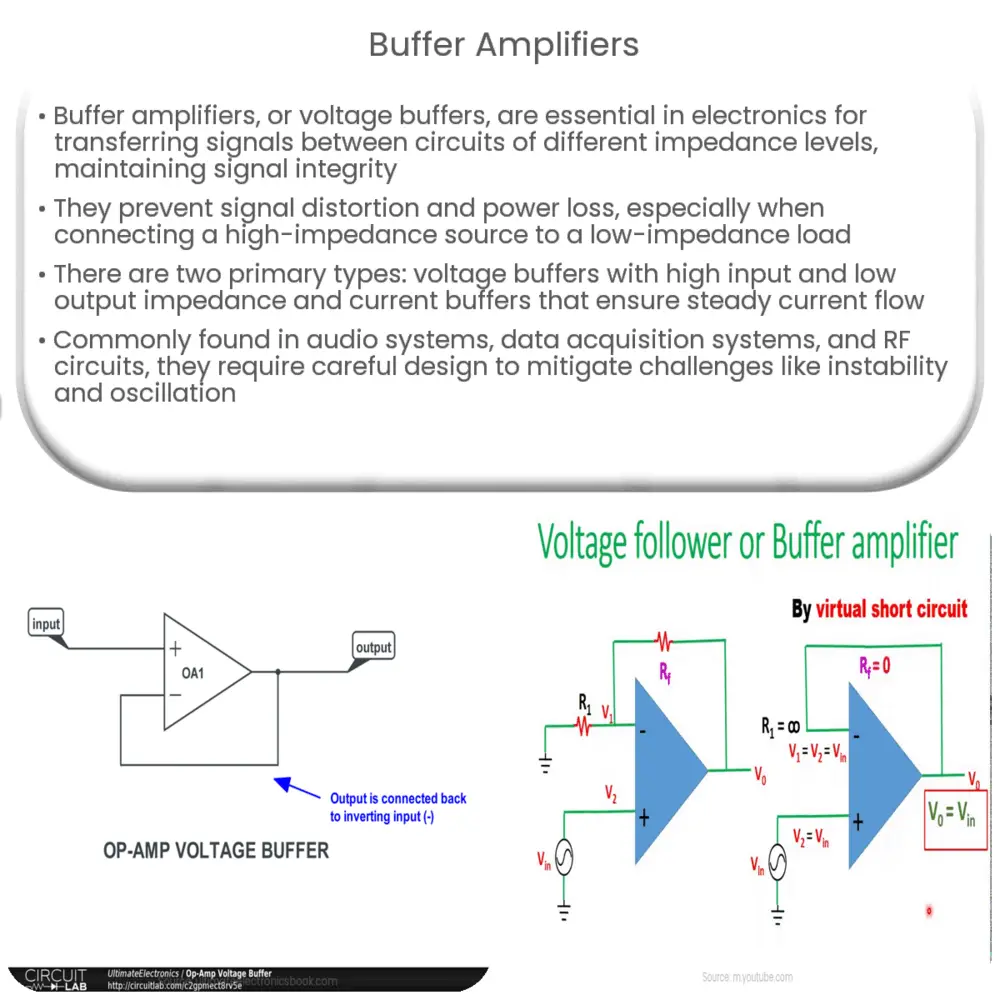Explore the fundamentals of buffer amplifiers, their types, design principles, applications, advantages, and limitations in this comprehensive guide.

Introduction to Buffer Amplifiers
Buffer amplifiers, also known as voltage buffers, play a crucial role in the world of electronics, particularly in the realm of signal processing circuits. Serving as an interface between two circuits with different impedance levels, these specialized amplifiers ensure the integrity of the signal is maintained while it is transferred from one circuit to the other.
Role and Significance
Buffer amplifiers are designed to prevent signal distortion and power loss which might occur when a high-impedance signal source is connected directly to a low-impedance load. By ensuring an appropriate impedance match, buffer amplifiers not only help maintain the original waveform but also maximize power transfer. Consequently, they find widespread application in devices and systems that heavily depend on accurate signal representation, such as audio systems, data acquisition systems, and communication devices.
Types of Buffer Amplifiers
-
Voltage Buffers: These are most commonly used buffer amplifiers. They have high input impedance and low output impedance, which means they can take an input signal without significantly loading the source circuit and can deliver the signal to the next stage without significant voltage drop.
-
Current Buffers: Unlike voltage buffers, current buffers are designed to ensure a steady current flow. They have low input impedance and high output impedance, making them ideally suited for applications where the current rather than the voltage is of primary importance.
Working Principle of Buffer Amplifiers
At the core of a buffer amplifier’s operation lies the principle of impedance transformation. High-impedance sources tend to produce low current and hence are more susceptible to current-related distortions when connected to a low-impedance load. A buffer amplifier, with its high input impedance, presents an almost open circuit to the source, minimizing the current drawn. Simultaneously, its low output impedance allows for delivering a high current to the load, thus maintaining the integrity of the signal.
Buffer Amplifier Design
The most common design for a voltage buffer amplifier is the ‘unity-gain amplifier’, often implemented using an operational amplifier (op-amp) in a feedback configuration. The op-amp’s high input impedance, low output impedance, and high gain characteristics make it a popular choice for buffer amplifier design. The unity-gain configuration ensures the output voltage is equal to the input voltage, hence providing an ‘amplification’ of 1 or ‘unity gain’.
Applications of Buffer Amplifiers
Buffer amplifiers find usage in a wide variety of applications due to their ability to prevent signal distortion and ensure effective power transfer. Here are some of the key applications:
-
Audio Systems: In audio systems, buffer amplifiers are often used to drive headphones or loudspeakers. They prevent any alterations to the audio signal caused by the interaction between the source and the speaker’s impedance, ensuring high-quality audio output.
-
Data Acquisition Systems: Buffer amplifiers can be used in data acquisition systems to isolate the data source from the measurement device. This ensures accurate readings by preventing any interaction between the device and the source.
-
Radio Frequency (RF) Circuits: In RF circuits, buffer amplifiers are used to isolate stages in an RF chain to prevent unwanted interactions or distortions.
Advantages and Limitations of Buffer Amplifiers
While buffer amplifiers come with a host of advantages, such as ensuring signal integrity, preventing signal distortion, and facilitating maximum power transfer, they are not without their limitations. One of the main challenges with buffer amplifiers is the need for careful design and configuration to prevent instability and oscillation. Further, like all electronic components, they are subject to non-idealities such as noise, distortion, and bandwidth limitations, which must be taken into account during the design process.
Conclusion
In conclusion, buffer amplifiers, with their ability to prevent signal distortion and ensure maximum power transfer, serve as a vital link in the chain of electronic signal processing. Their high input impedance and low output impedance allow them to interface effectively between high-impedance sources and low-impedance loads. While they do come with some design challenges and limitations, their utility in maintaining signal integrity and maximizing power transfer in a wide range of applications makes them an indispensable component in the world of electronics.



